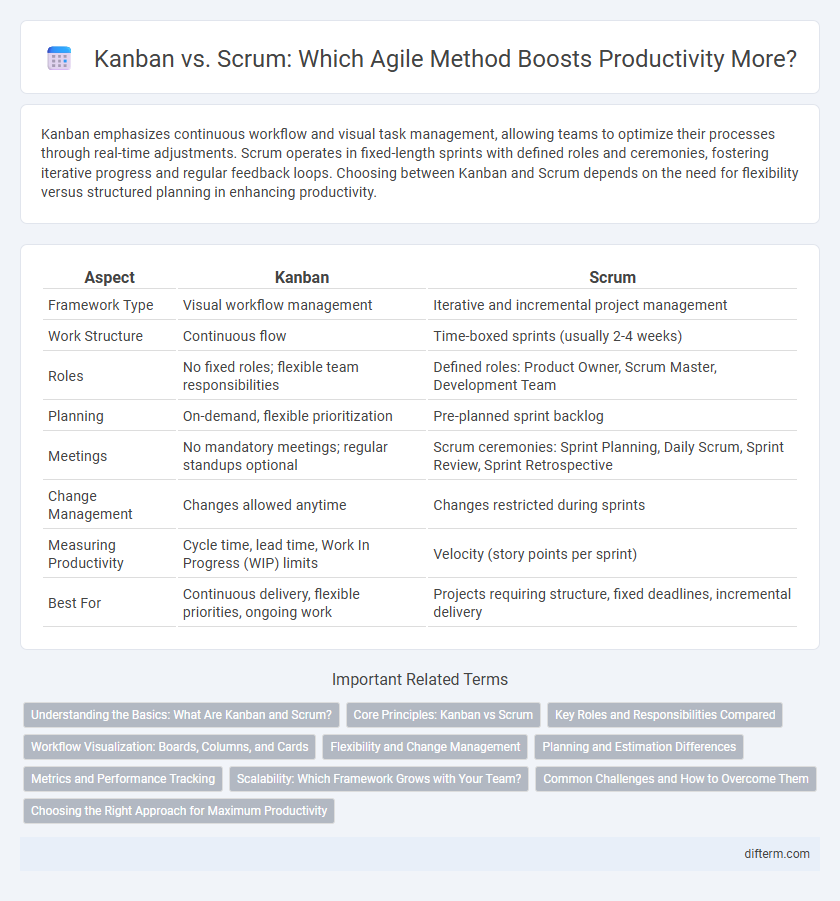Kanban emphasizes continuous workflow and visual task management, allowing teams to optimize their processes through real-time adjustments. Scrum operates in fixed-length sprints with defined roles and ceremonies, fostering iterative progress and regular feedback loops. Choosing between Kanban and Scrum depends on the need for flexibility versus structured planning in enhancing productivity.
Table of Comparison
| Aspect | Kanban | Scrum |
|---|---|---|
| Framework Type | Visual workflow management | Iterative and incremental project management |
| Work Structure | Continuous flow | Time-boxed sprints (usually 2-4 weeks) |
| Roles | No fixed roles; flexible team responsibilities | Defined roles: Product Owner, Scrum Master, Development Team |
| Planning | On-demand, flexible prioritization | Pre-planned sprint backlog |
| Meetings | No mandatory meetings; regular standups optional | Scrum ceremonies: Sprint Planning, Daily Scrum, Sprint Review, Sprint Retrospective |
| Change Management | Changes allowed anytime | Changes restricted during sprints |
| Measuring Productivity | Cycle time, lead time, Work In Progress (WIP) limits | Velocity (story points per sprint) |
| Best For | Continuous delivery, flexible priorities, ongoing work | Projects requiring structure, fixed deadlines, incremental delivery |
Understanding the Basics: What Are Kanban and Scrum?
Kanban is a visual workflow management method that uses boards and cards to optimize task flow and improve efficiency by limiting work in progress. Scrum is an agile framework centered on fixed-length iterations called sprints, with defined roles such as Scrum Master and Product Owner to promote collaboration and iterative progress. Both methodologies aim to enhance productivity but differ in structure, flexibility, and approach to task prioritization.
Core Principles: Kanban vs Scrum
Kanban emphasizes visualizing workflow, limiting work in progress (WIP), and continuous delivery to enhance productivity and reduce bottlenecks. Scrum centers around fixed-length sprints, defined roles, and regular sprint reviews and retrospectives to foster iterative progress and team collaboration. Both methodologies promote transparency and adaptability but apply distinct frameworks tailored to different project dynamics and team structures.
Key Roles and Responsibilities Compared
Kanban emphasizes continuous flow and limits work in progress, assigning roles flexibly without strict prescriptions, often with a Service Delivery Manager or Flow Manager overseeing the process. Scrum defines specific roles such as Product Owner, Scrum Master, and Development Team, each with clear responsibilities to manage backlogs, facilitate ceremonies, and deliver increments. The main difference lies in Scrum's structured accountability and role delineation versus Kanban's adaptable and fluid responsibilities aimed at optimizing workflow efficiency.
Workflow Visualization: Boards, Columns, and Cards
Kanban employs visual boards with columns representing work stages and cards symbolizing individual tasks, enhancing workflow transparency and continuous delivery. Scrum uses similar boards during sprints, where columns track task progress from backlog to done, supporting iterative development and team collaboration. Both methodologies leverage visual workflow tools to identify bottlenecks, improve task management, and boost overall productivity.
Flexibility and Change Management
Kanban offers superior flexibility by allowing teams to continuously prioritize and adjust work items on the board, making it ideal for projects with evolving requirements. Scrum operates in fixed-length sprints, which can limit immediate changes but provides structured review points to incorporate feedback systematically. Effective change management in Kanban relies on real-time updates, while Scrum leverages sprint retrospectives to evaluate and implement process improvements.
Planning and Estimation Differences
Kanban emphasizes continuous flow and limits work in progress without fixed iterations, allowing teams to plan and estimate tasks on an as-needed basis, enhancing flexibility in managing priorities. Scrum utilizes time-boxed sprints with predefined planning sessions to estimate work using story points or hours, fostering predictable delivery and velocity tracking. The primary difference lies in Kanban's adaptive, ongoing planning versus Scrum's structured, time-bound estimation and commitment cycles.
Metrics and Performance Tracking
Kanban uses continuous flow metrics such as cycle time and cumulative flow diagrams to track performance, emphasizing work-in-progress limits and real-time visualization for productivity improvements. Scrum relies on sprint-based metrics like velocity, sprint burndown, and release burndown charts to measure team output and predict future deliverables within fixed timeboxes. Both frameworks provide actionable insights but Kanban offers more granular, ongoing tracking, while Scrum focuses on iterative progress and team capacity.
Scalability: Which Framework Grows with Your Team?
Kanban offers high scalability by allowing teams to visualize workflows and adapt continuously without rigid roles, making it ideal for evolving project needs and varying team sizes. Scrum provides structured scalability through frameworks like Scrum of Scrums and Nexus, which support coordination across multiple teams but require strict adherence to prescribed roles and ceremonies. Teams aiming for flexible growth may prefer Kanban's fluid approach, while those needing regimented scaling benefit from Scrum's systematic multi-team integration.
Common Challenges and How to Overcome Them
Kanban and Scrum both face common challenges such as resistance to change, unclear roles, and difficulty maintaining workflow consistency. Overcoming these issues requires implementing clear communication channels, continuous team training, and adapting processes to fit the unique needs of the project. Leveraging visual management tools and frequent retrospectives enhances team alignment and accountability for improved productivity.
Choosing the Right Approach for Maximum Productivity
Kanban and Scrum offer distinct productivity benefits depending on project dynamics and team preferences; Kanban provides continuous workflow visualization and flexibility, ideal for ongoing tasks and incremental improvements, while Scrum structures work into fixed sprints with defined roles, promoting focused goal achievement and regular feedback. Teams prioritizing adaptability and real-time task management often favor Kanban, whereas those requiring clear deadlines, iterative progress, and collaborative planning benefit from Scrum methodologies. Evaluating project complexity, team size, and delivery timelines ensures selecting the optimal framework that maximizes efficiency and output quality.
Kanban vs Scrum Infographic

 difterm.com
difterm.com